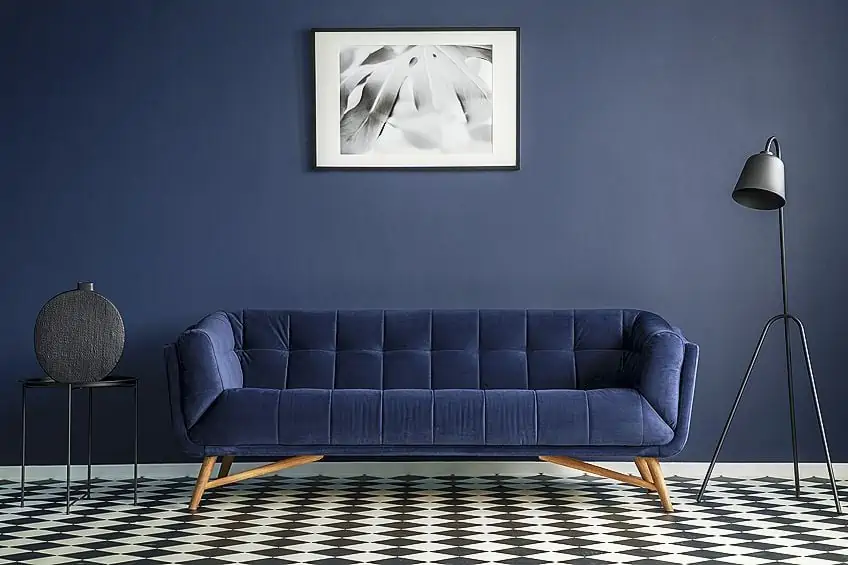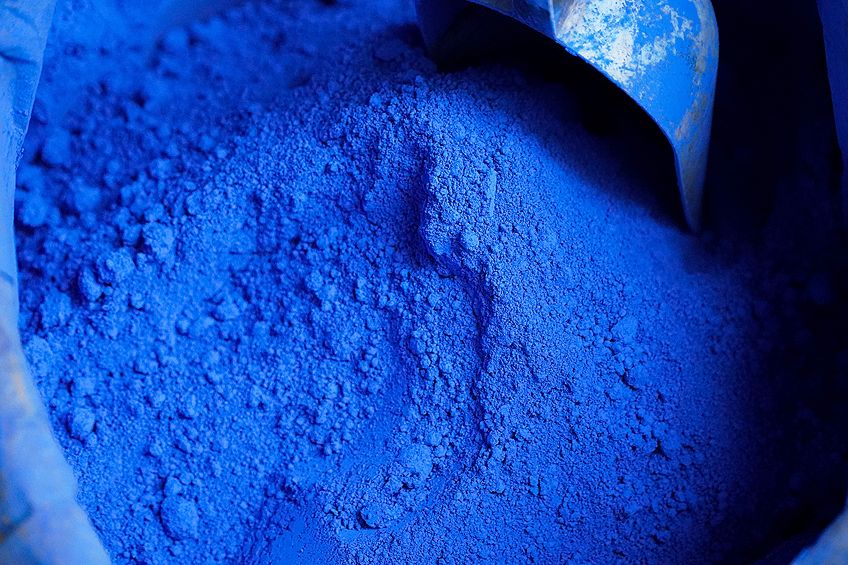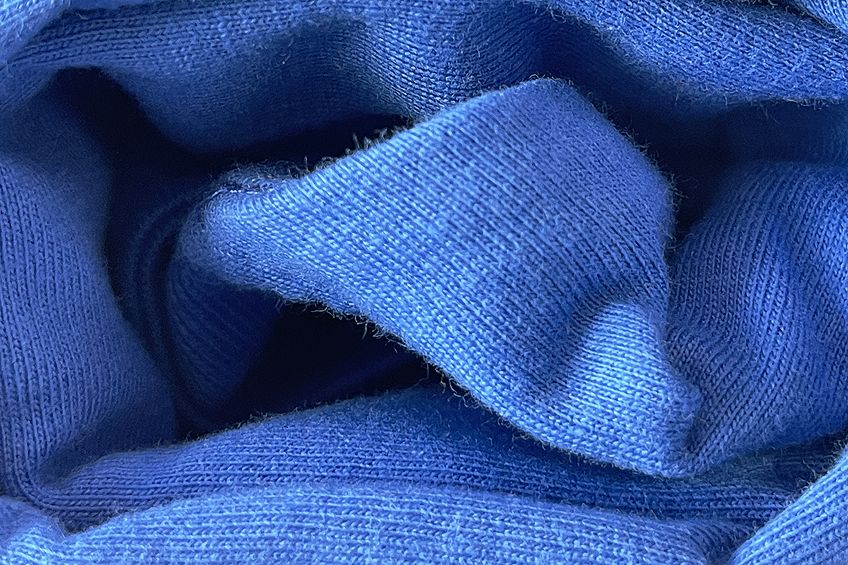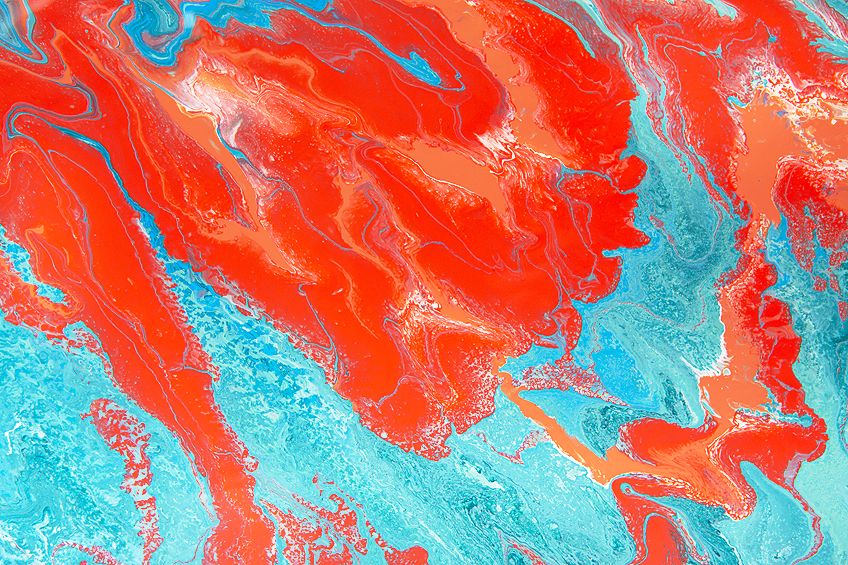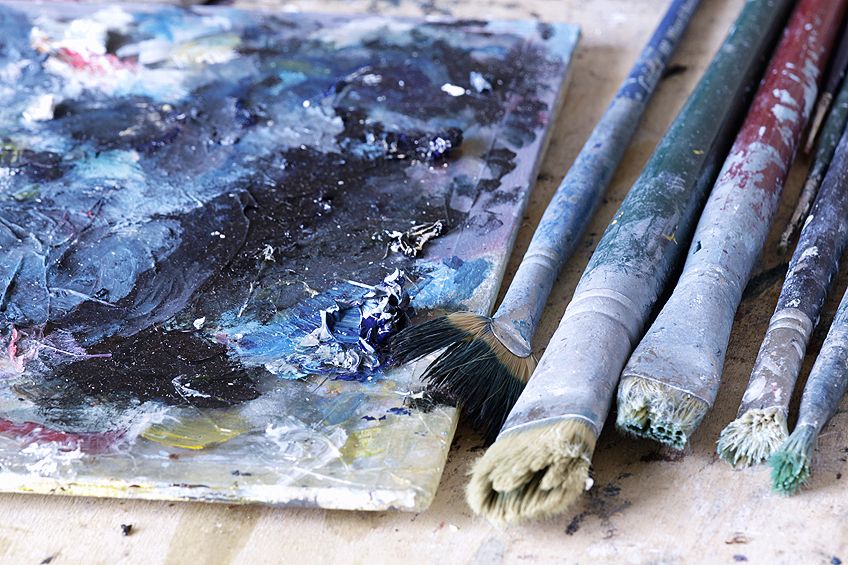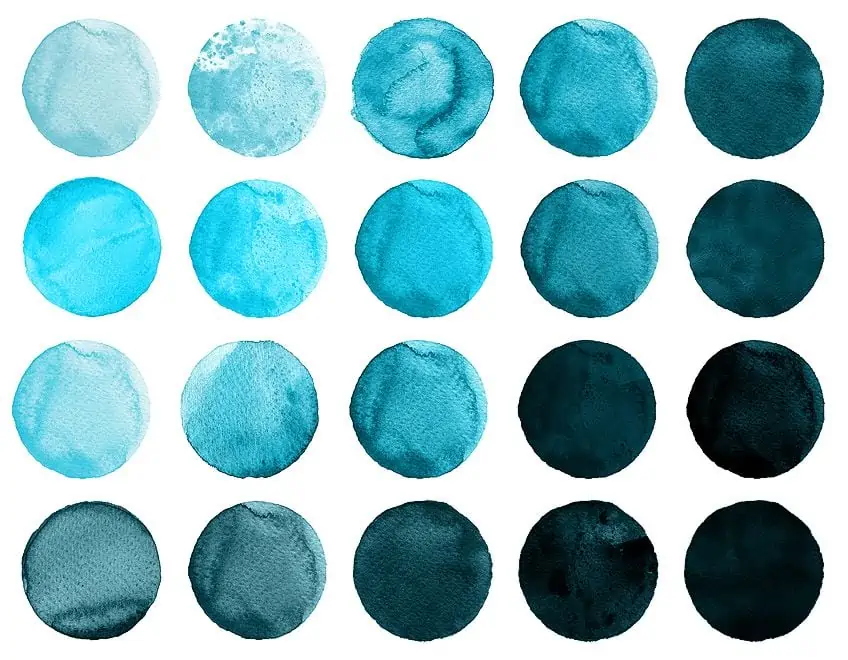What Colors Make Blue? – Learning How to Make Blue Paint
Blue is a color that is used by many artists nowadays. In addition, when compared to other hues, you will see that that blue occurs on most color palettes. As a result, understanding what colors make blue is essential to understanding how to mix colors to create the many shades of blue that you need. This article will assist you in understanding what color make blue and how you can make different shades of blue.
Contents
What Is Blue?
Blue is a color that may be found in abundance in nature, like the mild blue of a midday sky or the vast, deep blues of the water, among other things. Blue is commonly described as a color of tranquility and serenity because of this.
To many individuals, blue seems to be a safe and non-threatening hue that is also considered conservative and conventional.
The color blue evokes thoughts of tranquility and serenity in the viewer. It is often characterized as calm, quiet, secure, and well-ordered. However, the color blue may also conjure up images of ice and frost, and it can quickly make you feel more awake and attentive. It doesn’t matter whether you’re looking up at the beautiful blue sky or down into crystal-clear water pools; everyone is drawn to blue in some way.
| Color | RGB Code | Hex Code | CMYK Value |
| (0, 0, 255) | #0000FF | (100, 100, 0, 0) |
History of Blue
Among Earth’s most magnificent natural features are the sky and the ocean, both of which are represented by the color blue. The ancient Egyptians were the first to discover how to make a permanent pigment, which they then used for ornamental purposes in their art and architecture.
After that, the hue blue continued to develop for thousands of years, and some pigments were even utilized by some of the world’s greatest painters to produce some of the world’s most iconic pieces of art.
Today, it is still evolving, with the most recent shade uncovered less than a decade ago. The color was held in great respect by the Egyptians, who used blue to paint pottery, sculptures, and even the graves of the emperors to beautify them.
What Colors Make Blue?
When it comes to blue, there are many different colors and shades to choose from. The various shades of blue are available in warm, bright, dark, and muted tones. Since blue is a primary color, several people seem to believe that you cannot create it from scratch using color mixes. This is true to some extent.
However, it is possible to create blue by mixing different colors in the CMYK model. This model uses mixtures of the hues cyan, magenta, and yellow as pigments. Once you have mastered the art of making blue, you may experiment with different shades of blue to suit your purposes.
What Two Colors Make Blue?
Contrary to popular belief, combining two colors to create blue is not impossible when utilizing the CMYK color model, which consists of the hues cyan, magenta, and yellow. The color blue may be created by combining magenta and cyan.
Cyan is a color that has wavelengths that are between those of green and blue. Magenta can be described as purplish-red while cyan is described as a greenish-blue color.
| Color Name | Color | RGB Value | Hex Code | CMYK Value |
| Cyan | (0, 255, 255) | #00FFFF | (100 0, 0, 0) | |
| Magenta | (255, 0, 255) | #FF00FF | (0, 100, 0, 0) | |
| Yellow | (255, 255, 0) | #FFFF00 | (0, 0, 100, 0) |
Different Shades of Blue
The fact that color impacts mood is no secret, yet certain hues are more calming than others depending on the situation. Blue is an example of such a color. To such an extent that it may even assist lower stress levels, blue may elicit emotions of peace and relaxation. The color is available in many shades, which are described below.
This hue has been used in art, ceramics, clothes, as well as other products for hundreds of years due to its relaxing properties, and it continues to be popular today.
When compared to other blues, navy blue is an extremely deep shade of blue. In several nations, this shade of blue has been utilized as a primary color in naval uniforms. The shade of blue is a great way of making a fashion statement without being too obvious. Several events, including graduation celebrations, weddings, and job interviews, call for the use of this hue.
| Color Name | Color | RGB Value | Hex Code | CMYK Value |
| Navy Blue | (0, 0, 128) | #000080 | (100, 100, 0, 50) |
Cobalt Blue
This shade is extremely popular among artists all over the globe. Cobalt blue is a stunning shade of blue that is refreshing and also beautiful. An absolute embodiment of coolness in every sense of the word, cobalt blue is characterized by its dark, deep, and mysterious appearance.
| Color Name | Color | RGB Value | Hex Code | CMYK Value |
| Cobalt Blue | (0, 71, 171) | #0047AB | (100, 58, 0, 33) |
Baby Blue
Baby blue is a color that is considered to be pastel. It was originally used in the 18th century, according to historical records. This represents the innocence and pleasure that newborns possess. However, while this shade is not distinctive to a certain gender, it is often associated with males.
| Color Name | Color | RGB Value | Hex Code | CMYK Value |
| Baby Blue | (137, 207, 240) | #89CFF0 | (43, 14, 0, 6) |
Turquoise
When it comes to shades of blue, turquoise is one of those that goes with almost everything in your wardrobe. The use of this color in both decorating and apparel enhances the attraction of any subject, attitude, or appearance. If you use this shade as the theme color for your space, even the walls of your room will look fantastic. A similar statement may be made about websites that use this shade, particularly those whose primary focus is on fashion and style.
| Color Name | Color | RGB Value | Hex Code | CMYK Value |
| Turquoise | (64, 224, 208) | #40E0D0 | (71, 0, 7, 12) |
Midnight Blue
This is a shade of blue that is connected with feelings of tranquility and calmness. It is a deep and rich shade of blue that a lot of people use today. Some computer displays may also show the color as black, although it will seem very much like a dark blue than a true black.
| Color Name | Color | RGB Value | Hex Code | CMYK Value |
| Midnight Blue | (25, 25, 112) | #191970 | (78, 78, 0, 56) |
Ultramarine Blue
Ultramarine shade is widely utilized as a wall paint because of its vast manufacture and inexpensive cost, making it a popular choice. Ultramarine is a color that is linked with the ocean. Known as the most calming color in the world, ultramarine is a beautiful shade of blue that mixes both violet and blue, giving it an extremely pleasant look.
| Color Name | Color | RGB Value | Hex Code | CMYK Value |
| Ultramarine Blue | (65, 102, 245) | #4166F5 | (73, 58, 0, 4) |
Royal Blue
The royal blue color gained popularity in the United Kingdom throughout the 17th century. It is a shade that is linked with the aristocracy. This shade of blue is very similar to navy blue; however, the two colors are very different. A royal blue shade is a dark variant of blue that contains a significant amount of black color. To generate deep shades of blue without affecting other colors, artists and designers tend to use these two colors.
| Color Name | Color | RGB Value | Hex Code | CMYK Value |
| Royal Blue | (65, 105, 225) | #4169E6 | (71, 53, 0, 12) |
How to Make Blue Paint
There are several ways you can use to make blue paint. With a little more knowledge of the most popular connotations of blue colors, it is time to go into the details of what colors form blue and how to make blue paint that is tailored to your specific task.
Based on the project that you are working on, you can create warm shades, cool shades, and even muted shades of blue!
Making Cool Shades of Blue Paint
The secret to creating a cool shade of blue lies in green. Adding a dash of green to your blue paint can make it cooler. The specific shade of green that you select will decide the ultimate shade of cool blue that you get.
The most commonly used shades of green when creating cool blue paint are veronese green and cadmium green.
Veronese green is a vivid and cold green that is ideal for creating cool blue colors. It is also known as Veronese emerald. Since Veronese green is already a cool tint, it has a little tendency to tilt toward light blue in appearance. Mixing Veronese green with ultramarine blue will produce a very cold and somewhat deeper blue tint as a consequence of the reaction. When it comes to creating a light and dazzling cooler blue, blending Veronese green with cobalt blue is a good option.
| Color Name | Color | RGB Value | Hex Code | CMYK Value |
| Veronese Green | (0, 166, 113) | #00A671 | (100, 0, 32, 35) | |
| Cadmium Green | (0, 107, 60) | #006B3c | (100, 0, 44, 58) |
Making Muted Shades of Blue Paint
Colors such as cadmium orange, which is vivid and extremely warm, are excellent choices for muting blue tones. It is possible to achieve an extremely warm, dismal, but also dark hue of blue by mixing cadmium orange with ultramarine blue.
Cadmium orange is also a fantastic option if you would like to mute cobalt blue.
This makes the cobalt blue seem significantly less vivid as a result of its muting properties. Blue colors are muted even more by burnt umber, which is another wonderful neutral. Because burnt umber is merely a deeper orange tone, it makes the blues appear darker and muted.
| Color Name | Color | RGB Value | Hex Code | CMYK Value |
| Cadmium Orange | (237, 135, 45) | #ED872D | (0, 43, 81, 7) |
Making Warm Shades of Blue Paint
Several colors may be used with a blue hue to create a warmer shade. The first color is alizarin crimson, and the other is burnt sienna, both of which are complementary. The impact of any of these colors will vary based on the shade of blue that you choose as your foundation color.
If you would like to create a warm blue, we suggest starting with a blue hue that is already rather warm in tone. Alizarin crimson is a deep red that is both warm and somewhat purple in tone. Since alizarin crimson is a bit purple in color, it is likely to include a trace amount of blue.
Burnt sienna is considerably deeper and warmer in appearance. When you use an ultramarine blue and burnt sienna combination, you will achieve a considerably deeper warm blue tone as the outcome. Burnt sienna is also somewhat cooler than alizarin crimson, therefore this mixture will be slightly cooler.
| Color Name | Color | RGB Value | Hex Code | CMYK Value |
| Burnt Sienna | (234, 126, 93) | #EA7E5D | (0, 46, 60, 8) | |
| Alizarin Crimson | (227, 38, 54) | #E32636 | (0 83, 76, 11) |
What Colors Make Dark Blue?
Now that we have an idea of the colors that make light blue, what colors make dark blue? To make dark blue, you can make use of several colors. An example of a color that you can use is dioxazine purple. This can help you to achieve a very dark blue color.
For example, mixing this color with ultramarine blue gives you an extremely rich and deep blue. You can also pair this with cobalt blue to get a dark blue. Dioxazine purple includes red pigments, which means that when it is paired with cobalt blue, it is likely to produce a somewhat subdued dark blue.
Burnt umber is an excellent choice for generating dark blue tones with cobalt and ultramarine blue that are both rich and vibrant. Since it includes a significant quantity of red, burnt umber will provide a considerably more subdued, somewhat brown dark blue tint. It is recommended to use burnt umber if you are looking for an extremely dark blue.
Adding a mix of phthalo green and alizarin crimson is the last choice you have for generating a deep blue hue. When these two extra colors are combined, the effects of burnt umber are mimicked and you will get results that are comparable to those obtained with burnt umber alone.
The use of brilliant blue shades in your artworks is a good thing, however, they are not always appropriate. You will need to produce some muted tones of your selected blue hue to get true depth and perspective in your artworks. Things can seem a touch gaudy if you don’t use subdued hues.
| Color Name | Color | RGB Value | Hex Code | CMYK Value |
| Ultramarine Blue | (65, 102, 245) | #4166F5 | (73, 58, 0, 4) | |
| Dioxazine Purple | (92, 58, 147) | #5C3A93 | (37, 61, 0, 42) | |
| Burnt Umber | (138, 51, 36) | #8A3324 | (0, 63, 74, 46) | |
| Phthalo Green | (18, 53, 36) | #123524 | (66, 0, 32, 79) |
What Colors Make Light Blue?
Knowing what colors make light blue shades is important if you would like to add light blue to your work. Making light blue hues is a straightforward procedure. The quickest and most frequent method of lightening your blue hues is by including a little amount of white into the design.
When ultramarine blue and white are combined, the result is a beautiful and vivid hue of cornflower blue.
By using white paint, you may draw attention to the warm undertones of the color. It is also possible to brighten a blue tint by adding a touch of light green or yellow. As such, mixing green with blue will give you a cool blue shade and light cyan.
| Color Name | Color | RGB Value | Hex Code | CMYK Value |
| Ultramarine Blue | (65, 102, 245) | #4166F5 | (73, 58, 0, 4) | |
| Cornflower Blue | (100, 149, 237) | #6495ED | (58, 37, 0, 7) | |
| Blue | (0, 0, 255) | #0000FF | (100, 100, 0, 0) | |
| Cyan | (0, 255, 255) | #00FFFF | (100 0, 0, 0) | |
| Green | (0, 128, 0) | #008000 | (100, 0, 100, 50) |
Making Shades of Blue Using the CMYK Color Model
Apart from the classic and straightforward theory of color that has ever been discussed so far, there is a whole other way of visualizing color from the one we are used to. When printing in color, the CMYK model is used, which allows printers to produce color by mixing varying percentages of the colors magenta, yellow, cyan, and black. The process of creating blue using this model is really simple!
Blue may be created by combining cyan with another color tone. But what colors make cyan turn into blue? Magenta is the answer to this. A mixture of magenta and cyan may be used to create a variety of blue colors. The proportion of these two hues will determine the ultimate shade of blue you get.
Tips for Mixing Different Shades of Blue
When creating different shades of blue, you have a wide range of choices based on how you want light and shadows to look in your artwork. There are a few tips to keep in mind to ensure that you attain the precise shade of blue you want without making mistakes.
- For a deeper shade of blue, colors like gray and black can be added to blue.
- If you want to achieve a lighter shade, a small amount of white can be added to the blue.
- When you mix red with blue, you will obtain a color that is more similar to purple.
- Depending on factors like texture as well as absorbency, the medium you choose will have an impact on the color proportions that you need to achieve the desired color result.
- Adding yellow to the blue paint results in a color that is more similar to green.
- When mixing colors, make sure to not add too much. A small dab of the colors is enough to give you the effect you are looking for.
- As an artist, it may be very beneficial to maintain a color mixing notebook, in which you can record your experimentation with color mixing for reference purposes in the future.
The color blue is a primary color and a prominent color in the spectrum of colors. When it comes to painting, blue is one of the most often used hues, and it occurs on color palettes more often than many other colors. As a result, you’ll benefit from learning more about blending various shades of blue and honing your color-blending skills. We hope that this article has provided you with a better understanding of what colors make blue, how to make blue paint, and everything you needed to know about blue.
Frequently Asked Questions
The color navy blue is an extremely dark hue of blue. It is available in different variations depending on how much black is put into the mixture. Using paint pigments, you may create this by combining equal volumes of orange paint and blue paint that have already been applied. It is important to note that the blue you’re using should be true blue and not a pre-mixed variety.
What Is the Best Way to Make Blue Lighter?
White may lighten any color. Keep in mind, though, that you should only use small quantities of white paint at a time. When mixing colors, always begin with the lighter shade and then gradually add the darker shade in small quantities, until the desired effect is achieved.
What Is the Complementary Color for Blue?
Colors that are complementary to one another are often found on opposing sides of the color wheel. As a result, orange is considered to be the complementary hue to blue. Orange may be used to tone down blue hues and to make them seem noticeably dimmer.
What Colors Make Cyan?
In the CMYK color model, cyan is made when you remove gray from red. If, on the other hand, you would like to know what colors make cyan in the RGB system, then mixing green and blue will give you cyan.
What Color Do Blue and Green Make?
The solution is determined by the proportions of each color. Adding a little amount of green to blue will produce a somewhat cool blue. If you mix a little blue with green, you will get a somewhat cooler hue of green as a result.
What Two Colors Make Blue?
According to the basic color theory, blue is a primary color and therefore cannot be made by mixing any other colors together. However, using the cyan model, it is possible to make blue by mixing cyan and magenta.
Megan is a writer and researcher who holds a degree in Social Sciences, with a specialization in Psychology and Environmental Science, from the University of Cape Town. Her dedication to acquiring knowledge and making a positive impact has driven her current work in promoting conscious and sustainable growth in Southern Africa. Megan’s interests encompass exploring the physical and psychological impacts of color in our environment on our mood and well-being. She is also passionate about the role of art and creativity, which has been an integral part of society since the beginning of human history. Since 2022, Megan has been contributing blog posts on painting and color theory at artfilemagazine.
Learn more about Megan van Schoor and about us.
Cite this Article
Megan, van Schoor, “What Colors Make Blue? – Learning How to Make Blue Paint.” artfilemagazine – Your Online Art Source. February 14, 2022. URL: https://artfilemagazine.com/what-colors-make-blue/
van Schoor, M. (2022, 14 February). What Colors Make Blue? – Learning How to Make Blue Paint. artfilemagazine – Your Online Art Source. https://artfilemagazine.com/what-colors-make-blue/
van Schoor, Megan. “What Colors Make Blue? – Learning How to Make Blue Paint.” artfilemagazine – Your Online Art Source, February 14, 2022. https://artfilemagazine.com/what-colors-make-blue/.






